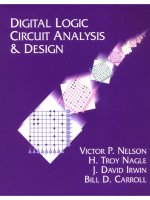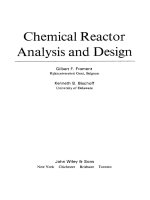Job analysis and design
Bạn đang xem bản rút gọn của tài liệu. Xem và tải ngay bản đầy đủ của tài liệu tại đây (514.2 KB, 42 trang )
Job Analysis and Design
Lecturer: Cao To Linh
ITP - 2010
Outlines
What is job?
Why organization needs job analysis?
Job analysis process
Job design and its challenges
Summary
Job?
Tasks: Coordinated and aggregated series of work elements
used to produce an output
Position: the responsibilities and duties performed by an
individual. There are as many positions in an organization as
there are employees
Job: group of positions that are similar in their duties, such
as computer programmer
Job family: group of two or more jobs that have similar
duties
Job description: the principal product of a job analysis. It
represents a written summary of the job as an identifiable
organizational unit
Job specification: a written explanation of the knowledge,
skills, abilities, traits, and other characteristics necessary for
effective performance on a given job
Why organization needs job analysis?
Job Analysis
Job Description Job Specification
is a systematic way to gather and
analyze information about the content
and human requirement of jobs, and the
context in which jobs are performed.
Job Design
HR planning
Recruitment
Selection
Training
Performance evaluation
Compensation
Job design and redesign
Why organization needs job analysis?
Job analysis is vital to any HRM program and answers
such questions as:
How long does it take to complete important tasks?
Which tasks are grouped together as a job?
How can a job be designed or structured so that
employee performance can be enhanced?
What behaviors are needed to perform the job?
What kind of person, in terms of traits and experience, is
best suited for the job?
How can the information acquired by a job analysis be
used in the development of HRM programs?
Job Analysis and Strategic HRM
The fundamental nature of work may be changing:
Functional areas are not as important as they once were
for defining a job
After reengineering of processes, new job
responsibilities may be poorly defined
Organizations must continually adapt to changing
business environments
Thus, reengineering is likely in most organizations
Job analysts traditionally create descriptions of jobs as
they currently exist
•
Now they must also describe future jobs
Job Analysis and Strategic HRM
There is a growing need to match human resource
activities to an organization’s strategic planning
Job specifications must accurately detail the
knowledge and skills that will complement future
strategic initiatives
Job descriptions will no longer be snapshots of a static
job
Strategic job analysis will have to capture both the
present and the future
Job Analysis and Strategic HRM
Compounding the problems of reengineering,
many work environments offer employees:
Compressed work schedules
Telecommuting
Job sharing
Flexible hours
Job Analysis & Employee Competencies
Competencies are general attributes employees need
across multiple jobs or within the organization
Includes anything from “teamwork” to “leadership potential”
Many organizations identify, communicate, and reward
competencies they believe employees should have
Competency modeling reflects an organization’s desire to:
Communicate job requirements in ways that extend beyond the
job itself
Describe and measure the organization’s workforce in more
general, competency-based terms
Design and implement staffing programs focused around
competencies, rather than specific jobs, as a way to increase
staffing flexibility
Job analysis process
Regardless of who collects the information, the individuals
should:
Thoroughly understand people, jobs, and the total organizational
system
Understand how work should flow within the organization
Sources of personnel in charge of job analysis:
Outside temporary analyst
Full-time job analyst
Supervisors
Job incumbents
Combination
Who Should Conduct the Job Analysis?
Before beginning analysis, an overview of the
organization and its jobs is required
This provides a better understanding of work flow
An organization chart presents the relationships
among departments and units of the firm, as well
as:
Line and staff functions
Number of vertical levels in the organization
Number of functional departments
Formal reporting relationships
The use of charts
A process chart shows how a specific set of jobs
relate to each other
This chart does not show structural relationships among
job titles
It shows the activities and work necessary to produce a
desired product or service
The use of charts
Methods of gathering information
When collecting job data, these basic methods can
be used separately or in some combination:
Observation
Interview
Questionnaires
Job incumbent diaries or logs
Observation
Applicable to the jobs that require manual, standardized,
and short-job-cycle activities
Job analysts must be trained to:
Observe relevant job behaviors
Be as unobtrusive as possible
Methods of gathering information
Interview
Interviewing job incumbents is often done in combination with observation
This is the most widely used technique
It allows the job analyst to talk with job incumbent
Interviews can be conducted with a:
Single incumbent
Group of incumbents
Supervisor who is familiar with the job
A structured set of questions is used so answers can be compared
Interviews are difficult to standardize
Different interviewers may ask different questions
The same interviewer might ask different questions of different respondents
Information may be unintentionally distorted by the interviewer
Interviewing costs can be high, especially if group interviews aren’t practical
Methods of gathering information
Methods of gathering information
Questionnaires
Questionnaires are the least costly data collection method
They can collect large amounts of data in a short time
A structured questionnaire includes specific questions about the job,
working conditions, and equipment
An open-ended format permits job incumbents to use their own words and
ideas to describe the job
The format and structure of a questionnaire are debatable
issues
To make a questionnaire easier to use:
Keep it as short as possible
Explain what the questionnaire is being used for
Keep it simple
Test the questionnaire before using it
Methods of gathering information
Job Incumbent Diary or Log
The diary or log is a recording by incumbents of:
Job duties
Frequency of the duties
When the duties are accomplished
Most people are not disciplined enough to keep a log
Kept properly, the log permits an examination of routine duties and
exceptions
The diary or log is useful when analyzing jobs that are difficult to observe
Which Method to Use?
There is no agreement about which methods of job
analysis yield the best information
Interviews should not be the sole data collection method
Certain methods may be better for a given situation
Most organizations base their choice on:
The purpose of the analysis
Time and budget constraints
Which Method to Use?
Many organizations use a multi-methods job
analysis approach
The analyst interviews incumbents and supervisors in
conjunction with on-site observation
A task survey based on expert judgments is
constructed and administered
A statistical analysis of the responses is conducted
Using a comprehensive process is relatively
expensive and time-consuming
The quality of information derived from a
comprehensive approach is strongly endorsed by
courts
Job Descriptions & Specifications
The job description is one of the primary outputs of
a systematic job analysis
It is a written description of what the job entails
It is hard to over-emphasize how important thorough, accurate, and
current job descriptions are to an organization
Changes in recent years have increased the need
for job descriptions:
Massive organizational restructurings
The need for new and creative ways to motivate and reward
employees
The accelerated rate at which technology is changing work
environments
New, more stringent regulation of employment practices
Job Descriptions & Specifications
There is no standard format for a job description,
but most well-written, useful descriptions include:
Job title
Summary
Equipment
Environment
Activities
A job specification evolves from the job description
It is especially useful for recruitment and selection
Job Descriptions & Specifications
R. J. Harvey’s guidelines for choosing the
characteristics included on a job specification:
All job tasks must be identified and rated in terms of importance,
using sound job analysis techniques
A panel of experts, incumbents, or supervisors should specify the
skills needed to perform each job task
The importance of each skill must be rated
Any other characteristics necessary for performing the job should
be identified (physical requirements, professional certification)
Each skill identified must be linked to a job task
Job Descriptions & Specifications
Any trait or skill stated on the job specification
should be required for performance of the job
The Americans with Disabilities Act makes the job analyst’s
responsibilities even greater in this area
Job specifications must differentiate between essential and
nonessential skills
•
Essential skills are those for which alternative ways of
accomplishing the job are not possible
•
Nonessential skills can be accommodated by changing the
structure or work methods of the job
Job Description & Specification









